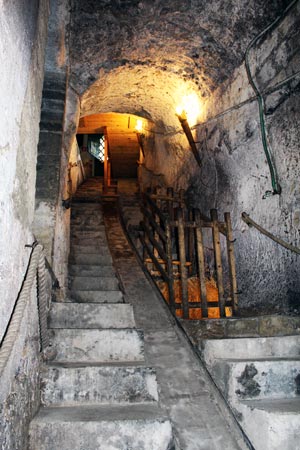Journey to the Center of Campania, or Preserving Time in a Bottle
Welcome to Dirty Boots and Dusty Bottles, an occasional series on the importing life in France, Italia and beyond. If you enjoy these tales, drop us a line to share your thoughts.
It’s the dirt. The way it looks. The way it smells. The way it sifts through your fingers as you scoop a handful from a dark corner of a 1,000-year-old cellar, knowing that at some point in history an ancient Roman probably did the same. And a seventeenth-century nobleman. Perhaps even an invading German soldier.
And now you.

The Mustilli family cave is a monument to time, a sacred place that holds a special power over anyone who walks through it, touches its black, volcanic-born walls and breathes its humid air. Since the fourteenth century, members of the Mustilli family have stashed bottles of wine, food for the winter, family treasures — even friends and relatives as foreign armies marched overhead — in this underground warren.
Just last May, our team visited this organic family estate in the medieval village of Sant’Agata dei Goti, inland from Naples in Campania.
After sharing a generous lunch with the family, we were eager to see the cave, to go beneath the ground and find the family’s roots, where all this history truly began.

It was in this cave where we discovered the soul of both the family and their wines — and understood why it was so important to generations of Mustillis that they carry the torch for Campania’s local traditions and native grapes.
Our underground guides were the Mustilli sisters, the driving force behind the family’s modern winery. Anna Chiara, with her close-cropped silver hair and piercing blue eyes, runs the vineyards and the cellar, while Paola, a broad smile under big glasses, runs the business side.
Ancient places have ancient energies. As we wandered through these narrow tunnels, some 45 feet below the ground, we all fell silent, breathing in the scents of aged wine and warm stone, touching the smooth wood of oak staves on wine barrels assembled in the cave by candlelight centuries ago. Paola shared stories of the cave as her playground, hiding in dark crevices from Anna Chiara while their father, Leonardo, drew samples of Falanghina from old cement tanks.

Watching Anna Chiara select various old vintages of wine from metal racks was a study in precision. Holding each bottle under a single bulb, she examined them one by one to ensure each was ready to make the journey from the center of the earth to the tasting room. It was here where we understood the family’s attention to detail, their commitment to capturing a grape’s true character — not just from the fields to the cellar, but through the path of time.
Finally, above ground, we made ourselves comfortable in the family’s old cantina, now a welcoming café and restaurant where the sisters’ husbands — both musicians — play guitar on the weekend and where Sunday lunch is an hours-long affair. Gingerly Anna Chiara pulled the corks from two of her first vintages as a winemaker, a 2002 Falanghina and a 2001 Greco di Tufo. Then we opened two more bottles from her father: a 1980 Falanghina and a 1977 Greco di Tufo.

Just as we had sifted the dirt of history and time through our hands below in the caves, we tasted through history and memory with the family, the wines more than able storytellers.
Powerful, expressive and full of life, holding both the significance of the past and excitement for the future — the wines spoke not only of the vibrant personalities of this generations-deep southern Italian family but of this unforgettable corner of Campania.
We can’t wait to return.

To learn more about our partners Azienda Agricola Mustilli and their wines, call a portfolio specialist at 800.266.6585.